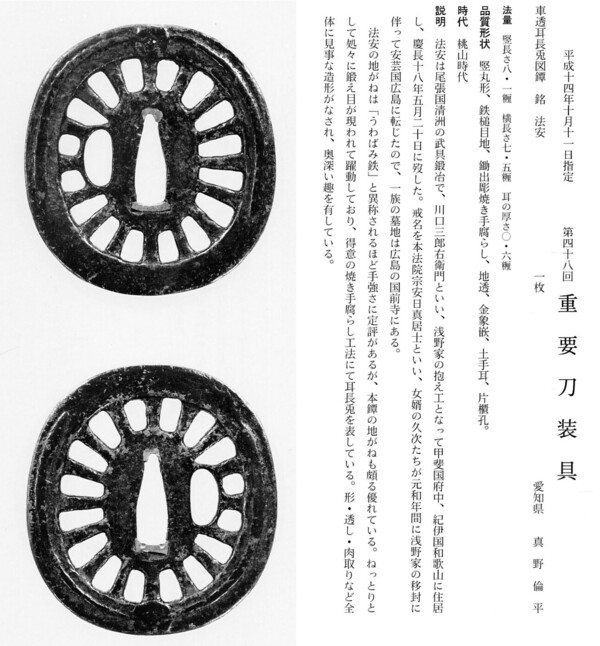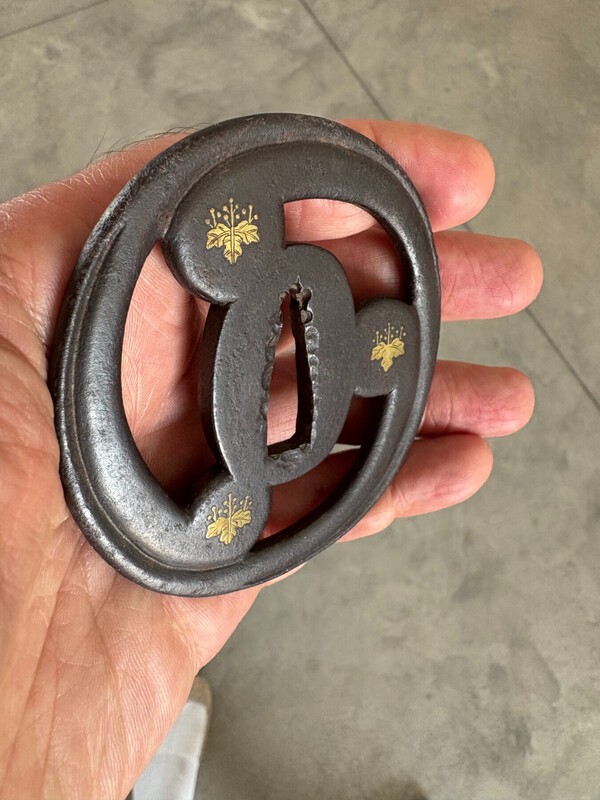-
Posts
962 -
Joined
-
Last visited
-
Days Won
4
Content Type
Profiles
Forums
Events
Store
Downloads
Gallery
Everything posted by Steve Waszak
-
A little further looking around turned up the following, a Juyo Shodai Hoan tsuba with accompanying text translated by Markus Sesko: "Jūyō-kodōgu at the 48th jūyō shinsa held on October 11, 2002 kuruma-sukashi miminaga-usagi no zu tsuba (車透耳長兎図鐔) - Tsuba with cart wheel sukashi and a design of long-eared rabbits mei: Hōan (法安) Measurements Height 8.1 cm, width 7.5 cm, thickness at rim 0.6 cm Description Hinshitsu-keijō: tatemaru-gata, iron, tsuchime-ji, sukidashibori, yakite-kusarashi, ji-sukashi, kinzōgan, dote-mimi, one hitsu-ana Jidai: Momoyama period. Explanation: Hōan was an armor smith who lived in Kiyosu (清洲) in Owari province and whose real name was Kawaguchi Saburō'emon (川口三郎右衞門). When he became employed by the Asano (浅野) family, he also worked from Fuchū (府中) in Kai province and in Wakayama (和歌山) in Kii province. He died on the 20th day of the fifth month of Keichō 18 (慶長, 1613) and his posthumous Buddhist name is Honpō'in Sō'an Nisshin (本法院宗安日真). His son-in-law Hisatsugu (久次) moved during the Genna era (元和, 1615-1624) on the occasion of the transfer of the Asano to Hiroshima (広島) in Aki province where the local Kokuzenji (国前寺) came to facilitate henceforth the graves of all members of the Kawaguchi family. The powerful iron of Hōan works is praised by the rather uncommon term uwabami-gane (うわばみ鉄), which means lit. "large snake steel," and the steel of this tsuba is exceptionally well forge[d]. It has the characteristic "stickyness," shows a forging structure in places, and an etched (yakite-kusarashi) design of long-eared rabbits which was the strong point of this artist. Shape, openwork, and distribution of the niku are gorgeous, giving this tsuba a very profound appearance." So, it seems the Shodai's death date is actually quite specific (May 20th, 1613). It also appears that the Shodai's remains were moved to Kokuzenji Temple in Aki (Hiroshima), presumably after (or at the same time that) the Asano and Hoan Hisatsugu were transferred to Aki in 1619. Many thanks to Markus Sesko for the translation, and to Rayhan for his generous work in supplying these Juyo Zufo texts for our learning and appreciation.
-
Here are two iron sukashi tsuba from my friend's collection, one an early-Edo Owari piece featuring a motif of varying tomoe and crossbars. While there are a few subtle tekkotsu in the rim, the tsuba overall presents as migaki-ji, rather than tsuchime-ji, leading me to date the tsuba to the early-Edo Period, rather than to Momoyama times. However, the large size of the guard has me thinking this could be late-Momoyama. The more conservative call, though, would be early-Edo. Dimensions are 8.4 cm x 8.4 cm x 6 mm, so, a very large ji-sukashi piece. These dimensions, in conjunction with the lively motif of the tomoe set against the solidity of the heavy crossbars, make for a bold presentation. The hitsuana are classic Owari in shape and size for the period. $285.00 plus shipping (PayPal Friends and Family). The second tsuba is likely a Shoami work (or would be likely to be categorized this way). It features a matsukawabishi motif element set against a botanical element (I cannot make out what kind of leaves these are), both set within the "namako" shaped large sukashi openings on the right and the left. With the slightly rounded rim and the particular kind of sukashi openings (namako), I would not tag this as Owari. A notable feature of the tsuba is the large nakago-ana, measuring 2.8 cm from the top to the bottom of the ana. The tsuba overall measures 7.8 cm x 7.7cm x 4 mm. $185.00 plus shipping.
-
The 1645 death date for the Shodai (if accurate) invites many questions, such as where, then, the 1613/1614 date comes from, and why he would have been buried at Kokuzanji Temple, which is in Kii Province (Wakayama Prefecture), if he'd worked for the Asano from 1619-1645 in Aki Province (Hiroshima). The Shodai moved from Owari to Kai Province to work for the Asano daimyo in that province, and then to Kii Province, continuing to work for the Asano family after they had been transferred there (Asano Yukinaga, the daimyo of Kii, died in 1613). It would seem to be more logical to conclude that, having worked for the Asano family in Kii province, he passed away there some five to six years before the Asano were transferred to Aki in 1619, and was then buried in Kokuzanji Temple, than that he would have lived the last 26 years of his life in Aki, only to then have his remains be interred in Kokuzanji in Kii in 1645. It's also odd that it is specified that Hisatsugu (second generation Hoan) accompanied the Asano to Aki Province in 1619, while the Shodai is not mentioned as having also done so. I wonder if the 1645 date given for Hisatsugu having become the "head" of the family might allude to some "technical" detail regarding official titles. I am more inclined to regard the 1613/1614 death date for the Shodai as more likely to be accurate.
-
This piece is one of the highlights of my friend's collection. It is a 2nd- (or possibly 3rd-) generation Kanshiro Nishigaki sukashi tsuba, featuring a lively double tomoe-plus-kirimon motif. The shape is very appealing, I think, being that wonderfully peculiar aori-gata form that Kanshiro appeared to be quite fond of. A standout aspect of the guard is the fluid motion of the kirimon motif elements: they are not stiff and static (as they might be in a straight up-and-down posture, which is what we usually see); rather, they sweep from 6:00 on the dial toward 12:00, curving upwards through the forming of the blossoms, bringing a lot of vitality to the subject. They are juxtaposed against the negative spaces forming the double tomoe; this contrast only enhances the lively expression in this piece. I'm not even sure these are the best parts of the sword guard, though, as the metal is just superb. It is wonderfully finished, with a fine migaki-ji which nevertheless admits very subtle tsuchime. This is masterwork in tsuba finishing. The color is deep, the patina natural, clear, and glossy (as opposed to shiny). There is just the slightest hint of remaining kebori on the leaves of the kirimon. If this tsuba were larger (8 cm or more), the price would be MUCH higher for this superb tsuba. For those looking to move into higher levels of collecting, I would personally highly recommend this piece. Were I myself not so strictly focused on Owari works, I'd have bought this from my friend myself. Dimensions are 7.3 cm x 7.1 cm x 3.5mm. $1,650.00, plus shipping. PayPal Friends and Family preferred.
-
The triple tomoe tsuba with brass inlaid kikumon motif has SOLD.
-
Update: I spoke to the friend whom I'm helping to move some tsuba so he can reorganize his collecting focus, and we agreed that the asking prices on these two tsuba should come down. So, each is now offered at $325.00, plus shipping.
-
Next up from the collection I'm assisting my friend in moving are two beautiful iron tsuba, one inlaid with brass in a quite, tasteful design, and the other presenting with a "splashy" display of foliage (maple leaves) in brass and perhaps silver on one side, and then, fascinatingly, with an entirely unanticipated and sophisticated geometric arrangement of linear elements. I have never seen another tsuba with such a starkly different aesthetic expression from one side to the other. The interior elements appear to be brass, while those on the periphery are silver(?). Unfortunately, there is a bit of inlay loss in the outlining of the seppa-dai on one side. There being no hitsuana in either tsuba helps with the strength of the design and expression in both sword guards. The nagamaru tsuba features a triple tomoe motif, with inlaid kiri-mon on the heads of each tomoe. All of the brass is intact on each side, and the iron appears to be very finely forged. A highly appealing tsuba, in my view. Dimensions are 7.9 cm x 7.5 cm x 3.5mm. $475.00 plus shipping. PayPal Friends and Family preferred. The other tsuba has a slight goishi-gata shape, being only about 2.5mm at the rim (approximately 3.5mm at the nakago-ana). This tsuba measures 8.2 cm and is close to perfectly marugata. Two udenuki-ana are present. $475.00 plus shipping. PayPal friends and family preferred.
-
You're quite welcome, Bobby. Happy to help if I can.
-
Hi Bobby, I believe the majority of these copies were 19th-century products, created out of the revivalist spirit that percolated through the Bakumatsu Period. At this time, there was a great nostalgia for the outstanding tsuba of times gone by, especially those of the Momoyama and early-Edo Periods. This is why we see many "homage" works copying the brilliant Nobuiye men of Momoyama, as well as of Yamakichibei, and then also Yagyu. The great father and son Norisuke tsubako of Owari Province -- who were excellent makers of iron tsuba in their own right -- are famous for their efforts to create worthy copies of Yamakichibei and Nobuiye. However, despite their dedication and skills, their works are a far cry from the genuine article, and they were among the very best at making these utsushi. This all goes to show that genius is difficult (read impossible) to replicate convincingly. Real is real, and if one wants that experience -- of seeing and appreciating and "bonding" with that genius, one must have the works of these early masters in hand. Photographs, even the best, simply cannot capture their magic.
-
You're very welcome.
-
Hi Bobby, I'm afraid that would be another "homage" piece. Many details -- from the plate work, shape, sukashi, surface finish, and mei -- are problematic. It can be difficult to see and appreciate the differences between the genuine early Yamakichibei work and that of those who made such "tribute" guards or outright copies. The early Yamakichibei tsuba possess a lively strength that later imitations don't really come close to. It is the same with the later Nobuiye copies or homage works: very far from the real thing.
-
Hi Alex, Well, there could be factors like aesthetics, structural reinforcement, and even just the personal preferences of the person commissioning the tsuba. In the two pieces I mentioned above, these are both ji-sukashi forms with quite a bit of "air" within/among the metal forming the sukashi walls and the rim. Perhaps the very thick rims could be seen as a way to "counter" the relative lack of material substance in the guard?
-
No worries, Marcin! It's great to ask questions. It's how we learn and make progress.
-
I have an Owari sukashi tsuba (Momoyama) with a 7mm rim, and a Kanayama guard (also Momoyama) with an 8mm rim. Not common, but they do exist.








.thumb.jpg.44081aeedc5e38899d5b2871f38d5659.jpg)
.thumb.jpg.0336aaee9ffa23e374b249afd6d64793.jpg)

.thumb.jpg.99877740540edd8896c32f8157fccc6e.jpg)
.thumb.jpg.56e92fb9c264ea13d536d3d1b3cf6f3a.jpg)
.thumb.jpg.0b499c1f550837a1c450baa624a8a88b.jpg)
.thumb.jpg.db5ab74211a9704874b37f1856a0e4fc.jpg)
.thumb.jpg.5cbde4a73b4cef75bc6d0f1382744502.jpg)
.thumb.jpg.dffecb1b1ae2db5aef665cd7a6a9c176.jpg)
.thumb.jpg.0a2359680c898355da6eb67ace3741af.jpg)
(1).thumb.jpg.1412c4ea66c1c70e2e753b8f28495f84.jpg)
(1).thumb.jpg.48d94b4a2a1bf0deccf19e9a23a33eda.jpg)
(1).thumb.jpg.9cde543d104313d7630f3458ae03fcdb.jpg)
(1).thumb.jpg.3b9517da1d2de5f99f95b71be34a918a.jpg)
(1).thumb.jpg.dddce1c3411fee6bab4bf3903757a5d6.jpg)
(1).thumb.jpg.53e5d910d4bce9f3ada98be884276061.jpg)
(1).thumb.jpg.014711dbf411836712eda24e9a15e5cb.jpg)
.thumb.jpg.ee7c96cd57aec114ae2cbb241ac33358.jpg)
.thumb.jpg.28d8eda63f0f2c25f7141a7f23f30aa3.jpg)
.thumb.jpg.0955cb7a888dba4f71742267c923b02c.jpg)
.thumb.jpg.7db473f5ba4b88d33469e4adcd3d7da9.jpg)
.thumb.jpg.2dcce4b9d56584b90224e72631756734.jpg)
.thumb.jpg.ae001c0d5f67070e7ed7127ec7f473ed.jpg)
.thumb.jpg.8acf7fc361238f0ace69cec1984a5bd6.jpg)


.thumb.jpg.b7e0830f83ed9ae3bb46e9f371068af0.jpg)
.thumb.jpg.f03bbbd4c3fcaba25cab3bb30a35cfc0.jpg)